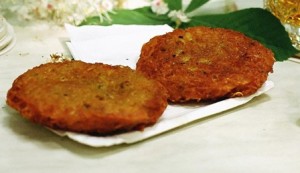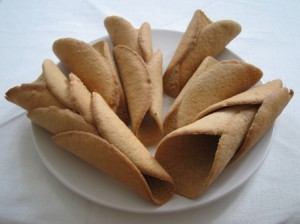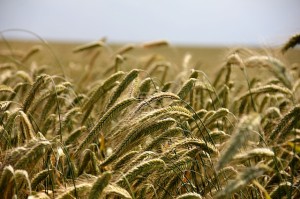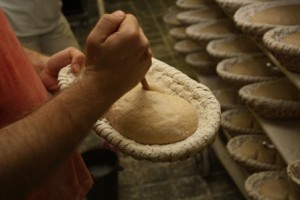The Silesian cuisine is quite rich regional cuisine of the northern part of Moravia and the area of southern Poland near the borders with Czech Republic. Local cuisine is influenced heavily by Polish and German cookery but also by Pomeranian and East-Prussian regional cuisine. Some of the specialities which have origin in the Silesian region are now cooked predominantly in Germany. Regional dishes are quite simple yet very tasty. Their preparation is based on local ingredients and culinary skills which are passed on from generation to generation.
Potatoes everywhere
 One of the traditional ingredients in Silesian cuisine is potatoes. These serve as a side dish, for potato soup, or as the main course in form of potato pancakes. Other ways of preparing potatoes include various mashes, dumplings or small gnocchi-like potato bits. Potatoes are cooked both peeled and unpeeled – in dependence on the recipe. They could be boiled in water, baked or fried. People usually drank fermented milk, buttermilk or usual fresh milk. Potato pancakes were made with raw potatoes, usually grated, and milk, eggs, flour, and to taste people usually add lots of garlic and marjoram which give these pancakes its unique flavour. The basic ingredients could be enriched by some kind of smoked meat like sausages or even bacon.
One of the traditional ingredients in Silesian cuisine is potatoes. These serve as a side dish, for potato soup, or as the main course in form of potato pancakes. Other ways of preparing potatoes include various mashes, dumplings or small gnocchi-like potato bits. Potatoes are cooked both peeled and unpeeled – in dependence on the recipe. They could be boiled in water, baked or fried. People usually drank fermented milk, buttermilk or usual fresh milk. Potato pancakes were made with raw potatoes, usually grated, and milk, eggs, flour, and to taste people usually add lots of garlic and marjoram which give these pancakes its unique flavour. The basic ingredients could be enriched by some kind of smoked meat like sausages or even bacon.
Various kinds of potato gnocchi and dumplings also have a long tradition not only in Silesia and the Czech Republic but also in Slovakia. Potatoes are used in dough which is then rolled up and boiled in a form of small cylinder and then it is sliced and served with meat and cabbage. Another way is to prepare the dough and by tearing it off with your fingers making small bits which are thrown into boiling water. When cooked, these small pieces of boiled potato dough are served with sheep cheese called bryndza or with cabbage, fried onion and bacon.
Bigos and Silesian Heaven
A traditional Polish appetizer prepared also in the border areas among Poland, Czech Republic and Germany is Bigos. This speciality is also known as the hunters stew and is made with cabbage and meat. Typical ingredients are cabbage or sauerkraut, whole or puréed tomatoes, honey, mushrooms and various cuts of meat and sausages. The meat used in bigos can be pork, ham, bacon, sausage, veal, beef and, since it is considered a hunter’s stew, it may include venison, rabbit or other game. Leftover cuts find their way into the pot as well. It may be seasoned with pepper, caraway, juniper berries, bay leaf, marjoram, paprika, dried or smoked plums, and other ingredients. Bigos is usually served with mashed potatoes or rye bread. As many other stews, this meal can be kept in a cool place and later reheated.
A very original meal, called Silesian heaven, is prepared with smoked bacon and dried fruit, cinnamon and lemon peel boiled in water. Then roux is prepared and made into a sweet sauce served with slices of bacon and the dried fruit. Silesian heaven goes well with potato dumplings.
 Various soups are an inseparable part of each meal in this regional cuisine. They are made with pretty much everything you find in a Silesian garden, but the most favourite ones are garlic soup, potato soup and cabbage soup. Cabbage, by the way, is also very popular and served as a side dish to various meals. As a dessert you can have local Ears of Štramberk (Štramberské uši), which is a kind of gingerbread pastry rolled into a shape resembling ears and, as the name suggests, it comes from nearby Štramberk. Silesian cuisine is undoubtedly very rich and has had great influence on the surrounding regions of Germany, Czech Republic and Poland and some of the meals from this region have become traditional parts of national cuisines of these countries.
Various soups are an inseparable part of each meal in this regional cuisine. They are made with pretty much everything you find in a Silesian garden, but the most favourite ones are garlic soup, potato soup and cabbage soup. Cabbage, by the way, is also very popular and served as a side dish to various meals. As a dessert you can have local Ears of Štramberk (Štramberské uši), which is a kind of gingerbread pastry rolled into a shape resembling ears and, as the name suggests, it comes from nearby Štramberk. Silesian cuisine is undoubtedly very rich and has had great influence on the surrounding regions of Germany, Czech Republic and Poland and some of the meals from this region have become traditional parts of national cuisines of these countries.


 Magdalena Dobromila Rettigová lived between 1785 and 1845. She was a Czech revivalist and author of cookbooks, poems, plays and short prose. Magdalena, by maiden name Artmannová, married a Czech lawyer, patriot and writer J. A. Rettig. She was brought up in German environment and her first writings were also in German. Under the influence of her husband and Czech writing society, she started to write in Czech and her “silly verses and weepy stories” were gaining in popularity.
Magdalena Dobromila Rettigová lived between 1785 and 1845. She was a Czech revivalist and author of cookbooks, poems, plays and short prose. Magdalena, by maiden name Artmannová, married a Czech lawyer, patriot and writer J. A. Rettig. She was brought up in German environment and her first writings were also in German. Under the influence of her husband and Czech writing society, she started to write in Czech and her “silly verses and weepy stories” were gaining in popularity. History of Czech lands dates back to the 9th century when Great Moravian Empire emerged from Slavic tribes. After collapse of Great Moravia in year 907 the centre of progress moved to Bohemia and Prague began to flourish. During the reign of Charles IV. in 14th century the Czech lands experienced great growth and many gothic and renaissance sights where built thanks to this king and Roman emperor. From 1526 House of Habsburg began to rule the country till the end of 1st World War. On 28th October 1918 the Czechoslovakia was established and was one of the most advanced countries in the world. Dark times started in 1938 when Hitler claimed Sudetenland and short after the whole country as Protectorate of Bohemia and Moravia. After the war Communist Party took over government and for 40 years stayed in charge of everything. Rule of this Party ended with Velvet Revolution in 1989 and modern history of Czech Republic started. Soon after that Czechs and Slovaks split up in 1993. Today Czech Republic is modern advanced country with focus on automobile and, of course, beer industry.
History of Czech lands dates back to the 9th century when Great Moravian Empire emerged from Slavic tribes. After collapse of Great Moravia in year 907 the centre of progress moved to Bohemia and Prague began to flourish. During the reign of Charles IV. in 14th century the Czech lands experienced great growth and many gothic and renaissance sights where built thanks to this king and Roman emperor. From 1526 House of Habsburg began to rule the country till the end of 1st World War. On 28th October 1918 the Czechoslovakia was established and was one of the most advanced countries in the world. Dark times started in 1938 when Hitler claimed Sudetenland and short after the whole country as Protectorate of Bohemia and Moravia. After the war Communist Party took over government and for 40 years stayed in charge of everything. Rule of this Party ended with Velvet Revolution in 1989 and modern history of Czech Republic started. Soon after that Czechs and Slovaks split up in 1993. Today Czech Republic is modern advanced country with focus on automobile and, of course, beer industry. wheat flours. Depending on the proportion of the two we then call the bread either rye-wheat bread (more ryeflour than wheatflour) or wheat-rye bread. The proportion of these two flours in the typical Czech bread varies and depends to a large extent on local customs. The most balanced option is a 1:1 ratio with slight predominance of wheat flour. The difference, when compared to standard white, purely wheat bread is really obvious.
wheat flours. Depending on the proportion of the two we then call the bread either rye-wheat bread (more ryeflour than wheatflour) or wheat-rye bread. The proportion of these two flours in the typical Czech bread varies and depends to a large extent on local customs. The most balanced option is a 1:1 ratio with slight predominance of wheat flour. The difference, when compared to standard white, purely wheat bread is really obvious. The credit for this process goes to enzymes, bacteria spores and yeast cells which are naturally contained in flour. The enzymes then simply begin degrading the flour starch into lower sugars. This provides a perfect culture medium for bacteria and yeast cells which start to reproduce themselves uncontrolledly.
The credit for this process goes to enzymes, bacteria spores and yeast cells which are naturally contained in flour. The enzymes then simply begin degrading the flour starch into lower sugars. This provides a perfect culture medium for bacteria and yeast cells which start to reproduce themselves uncontrolledly.